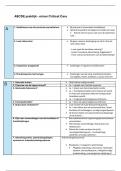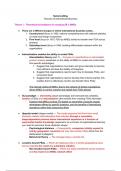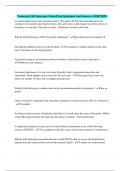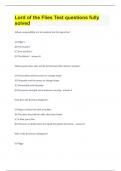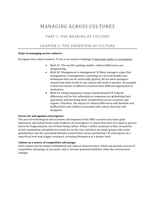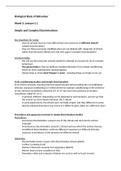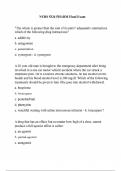Behavioral Finance
Lecture 1
Behavioral finance
Introduction
What is behavioral finance?
• Behavioural finance uses insights from psychology to understand how human behaviour
influences the decisions of investors, markets and managers.
• Behavioural Finance is a subfield of Behavioural economics, so they share foundations.
• Finance: Financial markets , corporate finance : individual decisions are the heart of the
field.
• Traditional Finance models have a basis in economics.
• Neoclassical economics is the dominant paradigm.
à Under this paradigm: Individuals and firms are self interested agents who maximize their
utility/ profits in the face of constrained resources.
• In Finance, utilities can be defined over security return, portfolio return.
• In Finance, we use discounted utility models to derive expected returns , to value assets
etc..
Traditional Finance started by centering valuations on rational economic behavior. Rational
economic behavior is modeled through Expected utility maximization.
• Behavioural finance emerged as a reaction to some market anomalies that
traditional theory - particularly EMicient Market Hypothesis (EMH) and models
based on investors rationality- failed to explain.
• Bubbles and financial crises are examples of such anomalies.
• A deeper understanding of those anomalies and the limits of traditional theory was
needed
In traditional economic model Agents are self interested, well informed and have distinct
preferences, they make decisions consistent with utility maximation (we will see later the
formalism of such theory . i.e axioms).
1
,Expected utility theory and Finance :
- Expected utility theory(EUT): faced with uncertainty, an individual would maximize
the expected utility across possible state of the world. à Applicable to individual
decision making (investor decision making)
- Financial asset can have innumerable possible future outcomes, EUT as it is , is
diMicult to applye à Asset pricing framework provides a framework to quantify the
tradeoM between risk and return. à Portfolio framework
- Asset pricing , portfolio theory have some common assumptions with the
Neoclassical model
Why behavioral finance?
Bring behavioral insights into the picture :
- Try to answer some empirical financial puzzles
- Use behavioral insights to improve individuals' decisions (savings, managerial
suboptimal decisions etc...)
Learning outcomes of the course
- Identify paradoxes/ inconcistensies of the Neoclassical model and tradional asset
pricing models
- Introduce alternative “behavioural” models
- Identify the importance of behavioural insights in explaining several financial
phenomena that touch diMerent dimensions of Finance:
o From decision maker/ investor perspective
o Behavioural insights into financial markets
o Behavioural insights into corporate finance
Topics
- Expected Utility Theory and its paradoxes
- Asset Pricing
- Market eMiciency and limits to arbitrage
- Bubbles and return extrapolations
- Prospect Theory
- Social preferences
- Decisions over Time
- Behavioral corporate finance
- Overconfidence
- Cognitive finance
2
,Expected value
Notation
We will talk a lot about risk, i.e. problems in which probabilities are objectively known,
observed.
We talk about uncertainty , when probability are unknown, not observed
A probability is a number between 0 and 1 that indicates a likelihood that a particular
outcome will occur.
0 means the event is impossible, 1 means it is certain.
Please note that risk for financial assets is assessed diMerently (variance, downside risk
etc..)
Example:
P (Heads) = 0.50
P (Rain tomorrow) = 0.30
The probability of all possible events must sum to 1:
P(Heads) + P(Tails) = 0.50 + 0.50 = 1
Pr (Rain) + Pr (Cloudy) + Pr (Sunny) = 0.30 + 0.10 + 0.60 = 1
Let’s focus mostly on binary prospects (i.e. lotteries), with two outcomes x > y and
probability p; we can write this as (x,p;y)
Alternatively, choices will be represented using decision trees:
We are then interested in preference relations between such prospects; ∼ indicates
indiMerence and ≻ strict preference (do not confuse this with inequalities >).
Expected value
Historically, the first theory used to model decision making under risk was expected value
theory : EVT
3
, Under EVT the value of a prospect is simply taken to be its mathematical expectation:
The expected value of a gamble is the value of each possible outcome times the probability
of that outcome.
In general for i outcomes:
Example:
Consider a proposed investment action x considered by an investor.
Buying some shares cheaply at initial issue of IPO , then resell them at higher price.
Assume one share costs 30p
Assume there are three outcomes :
Shares close at flotation cost : 30p à investor gets nothing (0p payoM)
Shares close at 60p à investor gets 30p payoM
Shares close at 90p à investor gets 60p payoM
Outcomes have equal probabilities of happening p≈0.33
Expected value of the “lottery”: 0.33x 0 30+ 0.33x 30 60 +0.33x 60 90 ≈ 30p (Expected value
is in term of payoMs not closing prices! NB: here we took approximately p=0.33 but it is
exactly p = 0.3333333333)
à This is a “fair bet” : the cost is equal to the expected value
Limits of EVT: St Petersburg Paradox
Consider the following prospect:
A fair coin is flipped with an equal chance of heads (H) or tails(T).
The player receives a prize everytime the flip comes up H. The game stops when the flip
comes up T.
4
Lecture 1
Behavioral finance
Introduction
What is behavioral finance?
• Behavioural finance uses insights from psychology to understand how human behaviour
influences the decisions of investors, markets and managers.
• Behavioural Finance is a subfield of Behavioural economics, so they share foundations.
• Finance: Financial markets , corporate finance : individual decisions are the heart of the
field.
• Traditional Finance models have a basis in economics.
• Neoclassical economics is the dominant paradigm.
à Under this paradigm: Individuals and firms are self interested agents who maximize their
utility/ profits in the face of constrained resources.
• In Finance, utilities can be defined over security return, portfolio return.
• In Finance, we use discounted utility models to derive expected returns , to value assets
etc..
Traditional Finance started by centering valuations on rational economic behavior. Rational
economic behavior is modeled through Expected utility maximization.
• Behavioural finance emerged as a reaction to some market anomalies that
traditional theory - particularly EMicient Market Hypothesis (EMH) and models
based on investors rationality- failed to explain.
• Bubbles and financial crises are examples of such anomalies.
• A deeper understanding of those anomalies and the limits of traditional theory was
needed
In traditional economic model Agents are self interested, well informed and have distinct
preferences, they make decisions consistent with utility maximation (we will see later the
formalism of such theory . i.e axioms).
1
,Expected utility theory and Finance :
- Expected utility theory(EUT): faced with uncertainty, an individual would maximize
the expected utility across possible state of the world. à Applicable to individual
decision making (investor decision making)
- Financial asset can have innumerable possible future outcomes, EUT as it is , is
diMicult to applye à Asset pricing framework provides a framework to quantify the
tradeoM between risk and return. à Portfolio framework
- Asset pricing , portfolio theory have some common assumptions with the
Neoclassical model
Why behavioral finance?
Bring behavioral insights into the picture :
- Try to answer some empirical financial puzzles
- Use behavioral insights to improve individuals' decisions (savings, managerial
suboptimal decisions etc...)
Learning outcomes of the course
- Identify paradoxes/ inconcistensies of the Neoclassical model and tradional asset
pricing models
- Introduce alternative “behavioural” models
- Identify the importance of behavioural insights in explaining several financial
phenomena that touch diMerent dimensions of Finance:
o From decision maker/ investor perspective
o Behavioural insights into financial markets
o Behavioural insights into corporate finance
Topics
- Expected Utility Theory and its paradoxes
- Asset Pricing
- Market eMiciency and limits to arbitrage
- Bubbles and return extrapolations
- Prospect Theory
- Social preferences
- Decisions over Time
- Behavioral corporate finance
- Overconfidence
- Cognitive finance
2
,Expected value
Notation
We will talk a lot about risk, i.e. problems in which probabilities are objectively known,
observed.
We talk about uncertainty , when probability are unknown, not observed
A probability is a number between 0 and 1 that indicates a likelihood that a particular
outcome will occur.
0 means the event is impossible, 1 means it is certain.
Please note that risk for financial assets is assessed diMerently (variance, downside risk
etc..)
Example:
P (Heads) = 0.50
P (Rain tomorrow) = 0.30
The probability of all possible events must sum to 1:
P(Heads) + P(Tails) = 0.50 + 0.50 = 1
Pr (Rain) + Pr (Cloudy) + Pr (Sunny) = 0.30 + 0.10 + 0.60 = 1
Let’s focus mostly on binary prospects (i.e. lotteries), with two outcomes x > y and
probability p; we can write this as (x,p;y)
Alternatively, choices will be represented using decision trees:
We are then interested in preference relations between such prospects; ∼ indicates
indiMerence and ≻ strict preference (do not confuse this with inequalities >).
Expected value
Historically, the first theory used to model decision making under risk was expected value
theory : EVT
3
, Under EVT the value of a prospect is simply taken to be its mathematical expectation:
The expected value of a gamble is the value of each possible outcome times the probability
of that outcome.
In general for i outcomes:
Example:
Consider a proposed investment action x considered by an investor.
Buying some shares cheaply at initial issue of IPO , then resell them at higher price.
Assume one share costs 30p
Assume there are three outcomes :
Shares close at flotation cost : 30p à investor gets nothing (0p payoM)
Shares close at 60p à investor gets 30p payoM
Shares close at 90p à investor gets 60p payoM
Outcomes have equal probabilities of happening p≈0.33
Expected value of the “lottery”: 0.33x 0 30+ 0.33x 30 60 +0.33x 60 90 ≈ 30p (Expected value
is in term of payoMs not closing prices! NB: here we took approximately p=0.33 but it is
exactly p = 0.3333333333)
à This is a “fair bet” : the cost is equal to the expected value
Limits of EVT: St Petersburg Paradox
Consider the following prospect:
A fair coin is flipped with an equal chance of heads (H) or tails(T).
The player receives a prize everytime the flip comes up H. The game stops when the flip
comes up T.
4


